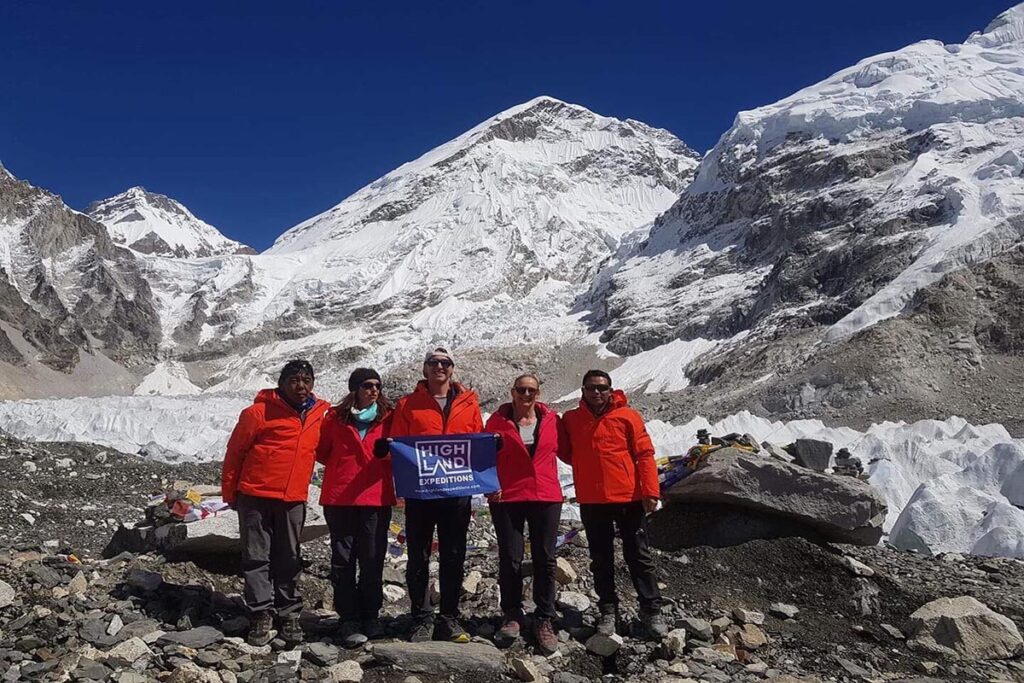Training for the Everest Base Camp trek involves a comprehensive approach to building physical stamina, strength, and mental resilience to prepare for the demanding high-altitude journey. The trek requires not only endurance but also the ability to adapt to challenging conditions, so a well-rounded training regimen is crucial for success.
Begin your training with a focus on cardiovascular endurance. The trek to EBC spans approximately 12 to 14 days, covering rugged terrains and significant altitude gains. To build endurance, incorporate long-distance hiking or running into your routine, aiming for at least 3 to 4 sessions per week. Gradually increase the duration and intensity of these workouts to simulate the trekking conditions you’ll encounter. Hiking on varied terrains, including inclines and rough trails, will help prepare your legs and lungs for the uphill and downhill challenges of the trek.
Strength training is equally important, particularly for your lower body and core. Exercises such as squats, lunges, and step-ups target the muscles used in climbing and descending, enhancing your ability to carry a backpack and manage uneven surfaces. Incorporating core-strengthening exercises like planks and leg raises will improve your stability and balance, which are essential for navigating the rocky trails of the Everest region.
Simulating high-altitude conditions through training is a key component of preparation. If possible, train in environments with reduced oxygen levels or use an altitude simulation mask to mimic the effects of high altitude. If this is not feasible, frequent elevation hikes and working out on a treadmill set to a high incline can help your body adjust to the physical demands of trekking at high altitudes.
Flexibility and balance are also vital for a successful trek. Incorporate stretching and yoga into your routine to enhance your range of motion and reduce the risk of injuries. Practicing balance exercises will help you navigate uneven trails more effectively.
Mental preparation is an often-overlooked aspect of training. High-altitude trekking can be as mentally challenging as it is physically demanding. Develop a positive mindset and resilience by setting and achieving incremental goals during your training, and prepare for potential altitude-related challenges by learning about altitude sickness and its symptoms.
Finally, simulate the trek experience by incorporating long hikes with a weighted backpack into your training schedule. Gradually increase the weight to match what you will carry during the trek, ensuring you are comfortable with the load. This will help your body adapt to the physical demands of the trek, including carrying gear and navigating challenging terrain.
Overall, a well-rounded training program that includes cardiovascular exercise, strength training, altitude simulation, flexibility, and mental preparation will build the stamina necessary for a successful Everest Base Camp trek. By following a structured training plan, you’ll enhance your physical readiness and improve your ability to tackle the challenges of high-altitude trekking.
Introduction to Training for the Trek
Training for the Everest Base Camp trek is essential for ensuring a successful and enjoyable adventure. This trek demands a high level of physical fitness and mental resilience due to the challenging terrain and the effects of high altitude. A well-structured training program helps prepare your body for the strenuous conditions you’ll face, improving your endurance, strength, and adaptability. It’s not just about building physical stamina but also about acclimating your body to the rigors of trekking at high altitudes. Effective training involves a combination of cardiovascular exercises, strength training, flexibility work, and altitude simulation. By investing time in your training, you can enhance your trekking experience, minimize the risk of injury, and better handle the physical demands of the journey.
Understanding High Altitude Challenges
Trekking to Everest Base Camp presents unique challenges primarily due to high altitude. As you ascend, the air becomes thinner, and oxygen levels decrease, which can lead to altitude sickness if your body doesn’t acclimate properly. High-altitude trekking requires not only physical stamina but also the ability to adapt to these reduced oxygen levels. Symptoms of altitude sickness can range from mild headaches and nausea to severe complications like pulmonary or cerebral edema. Training for high altitude involves preparing your cardiovascular system to handle reduced oxygen and increasing your body’s ability to cope with the physical stress of the trek. Understanding these challenges and training to address them will improve your chances of a safe and successful trek.
Assessing Your Current Fitness Level
Before embarking on a training regimen for the Everest Base Camp trek, it’s important to assess your current fitness level. This involves evaluating your cardiovascular endurance, strength, flexibility, and overall physical health. Start by conducting a fitness test that includes activities like running or hiking on varied terrain, as well as strength exercises such as squats and lunges. Assess how you perform and how quickly you recover from these activities. This initial evaluation helps in setting realistic training goals and designing a program that addresses your specific needs. It also provides a baseline against which you can measure progress as you advance through your training. Consulting with a fitness professional or a trekking coach can also provide valuable insights and guidance tailored to your individual fitness level.
Cardiovascular Training for Endurance
Cardiovascular training is crucial for building the endurance required for the Everest Base Camp trek. The trek involves long days of hiking, often with significant elevation gain, which places considerable demands on your heart and lungs. To prepare, incorporate activities such as running, cycling, or long-distance hiking into your training routine. Aim for at least 3 to 4 sessions per week, gradually increasing the intensity and duration of these workouts. Interval training can be particularly effective, as it simulates the varied paces you’ll encounter on the trek. Additionally, including incline training, such as hiking on steep hills or using a treadmill with an incline, helps mimic the conditions of the trek. Building cardiovascular endurance will improve your ability to handle the physical demands of long treks and enhance your overall stamina.
Strength Training: Key Muscle Groups to Target
Strength training is an integral part of preparing for the Everest Base Camp trek, as it strengthens the key muscle groups used during hiking. Focus on exercises that target the lower body, including the quadriceps, hamstrings, glutes, and calves, as these muscles are heavily used during ascents and descents. Incorporate exercises such as squats, lunges, step-ups, and calf raises into your routine. Additionally, strengthening your core muscles is essential for maintaining balance and stability on uneven terrain. Include exercises like planks, Russian twists, and leg raises. Upper body strength is also important for carrying a backpack and using trekking poles effectively, so incorporate exercises such as push-ups and rows. A balanced strength training program will improve your trekking performance and reduce the risk of injury.
Flexibility and Mobility Exercises
Flexibility and mobility exercises are vital for preparing your body for the demands of the Short Everest Base Camp trek. These exercises help improve your range of motion, prevent injuries, and enhance overall trekking performance. Incorporate activities such as dynamic stretching and yoga into your routine. Dynamic stretches, like leg swings and arm circles, should be performed before workouts to prepare your muscles and joints for exercise. Yoga routines focusing on poses that stretch and strengthen the legs, hips, and back can increase flexibility and help with balance and stability on uneven terrain. Additionally, mobility exercises like hip circles and ankle rolls can improve joint function and prevent stiffness. Regularly incorporating these exercises into your training regimen will help you handle the physical challenges of trekking more effectively and reduce the risk of strains and sprains.
Incorporating Hiking into Your Training
Incorporating hiking into your training routine is essential for preparing for the Everest Base Camp trek. Hiking on varied terrains, including hills and rough trails, closely simulates the conditions you’ll encounter during the trek. Start with shorter hikes and gradually increase the distance and elevation to build endurance and strength. If possible, choose trails with similar elevation gain and difficulty to what you’ll experience on your trek. Carrying a weighted backpack during these hikes will help you get used to the load you’ll be carrying on the trek, improving your overall comfort and stamina. Regular hiking also helps you get accustomed to the physical demands of long days on the trail, including uphill climbs and downhill descents. By integrating hiking into your training, you can better prepare your body and mind for the challenges of the Everest Base Camp trek.
Long-Distance Walking and Trekking
Long-distance walking and trekking are crucial for building the endurance needed for the Everest Base Camp trek. To prepare, include long walks and treks in your training routine, gradually increasing the distance over time. Aim to complete at least one long-distance session per week, simulating the duration and intensity of the trek. Walking on different terrains, such as trails and inclines, will help you adapt to the varied conditions you’ll face. Additionally, walking with a weighted pack can improve your stamina and comfort during the trek. As you build up your distance, focus on maintaining a steady pace and managing your energy levels, as these are critical for enduring long days of trekking. Long-distance walking will enhance your physical endurance and mental resilience, key components for a successful Everest Base Camp adventure.
Altitude Training Techniques
Altitude training techniques are designed to help your body adapt to the reduced oxygen levels encountered at high altitudes. While it is challenging to fully replicate high-altitude conditions, there are several methods that can improve your acclimatization. If possible, train in high-altitude environments or use altitude simulation equipment like masks or hypoxic tents that reduce oxygen levels. Another effective method is to incorporate interval training and high-intensity workouts that mimic the physical stress of high altitudes. Gradually increasing your training intensity and incorporating periods of rest can also help improve your cardiovascular efficiency. Additionally, spending time at elevated elevations before your trek, such as hiking in mountainous areas, can help your body adjust to lower oxygen levels. Altitude training enhances your body’s ability to handle reduced oxygen, improving your overall performance and comfort on the trek.
Nutrition Tips to Support Your Training
Proper nutrition is essential to support your training and prepare your body for the Everest Base Camp trek. A well-balanced diet will provide the energy and nutrients necessary for rigorous physical activity and recovery. Focus on consuming a mix of carbohydrates, proteins, and healthy fats. Carbohydrates, such as whole grains, fruits, and vegetables, provide the energy needed for endurance training. Protein sources like lean meats, fish, and legumes help with muscle repair and recovery. Healthy fats from sources such as nuts, seeds, and avocados support sustained energy levels. Staying hydrated is equally important, so ensure you drink plenty of water before, during, and after workouts. Incorporate electrolytes and vitamins to support overall health and immune function. Additionally, eating smaller, frequent meals can help maintain energy levels and prevent fatigue. Proper nutrition will enhance your training performance, support recovery, and prepare you for the physical demands of the trek.
Sample Training Schedule
A well-structured training schedule is crucial for preparing for the Everest Base Camp trek Adventure. A typical week might include a mix of cardiovascular, strength, and flexibility workouts. Begin with a cardiovascular workout, such as a long hike or run, on Monday, aiming for 60-90 minutes of steady activity. On Tuesday, focus on strength training, targeting the lower body with exercises like squats and lunges, and include core exercises such as planks. Wednesday could be dedicated to a rest or active recovery day, incorporating light stretching or yoga. On Thursday, perform a high-intensity interval training (HIIT) session to build stamina and simulate the demands of trekking. Friday can be another strength training day, focusing on upper body and core muscles. Saturday should involve a longer hike or trek with a weighted backpack, gradually increasing distance and elevation. Finish the week with a lighter activity on Sunday, such as a relaxed walk or yoga session, to aid in recovery. Adjust the intensity and duration based on your fitness level and progression. This balanced approach ensures you build endurance, strength, and flexibility while preparing for the varied demands of the trek.
Importance of Rest and Recovery
Rest and recovery are essential components of any effective training program, especially for the physically demanding Everest Base Camp trek. Training hard without adequate rest can lead to overtraining, fatigue, and increased risk of injury. Rest days allow your muscles to repair and strengthen, preventing burnout and ensuring continuous progress. Active recovery, such as light stretching, yoga, or leisurely walks, helps maintain flexibility and circulation while promoting recovery. Adequate sleep is also crucial, as it supports muscle repair, cognitive function, and overall well-being. Incorporating rest days into your training schedule allows your body to adapt to the increasing physical demands and reduces the risk of injuries. Prioritizing recovery ensures that you remain physically and mentally prepared for the trek, enhancing your overall performance and enjoyment of the adventure.
Mental Preparation for the Trek
Mental preparation is as important as physical training for the Everest Base Camp trek. The trek presents not only physical challenges but also significant psychological demands, including managing stress, overcoming self-doubt, and staying motivated through long and arduous days. To build mental resilience, incorporate techniques such as visualization and goal setting into your training. Visualize successfully completing the trek and overcoming challenges to boost confidence and motivation. Setting small, achievable goals during your training can help build a positive mindset and track progress. Additionally, practice mindfulness or meditation to improve focus and manage anxiety. Preparing mentally for the trek involves understanding the potential challenges, developing coping strategies, and fostering a positive attitude. This mental readiness will help you tackle the physical and psychological demands of the trek, ensuring a more rewarding and enjoyable experience.
Gear and Equipment for Training
Using appropriate gear and equipment during your training helps simulate the conditions of the Everest Base Camp trek and prepares you for the physical demands of the journey. Invest in quality hiking boots that offer good support and traction, as they are essential for navigating rough terrain. A weighted backpack, similar to what you’ll carry on the trek, is crucial for training sessions to build strength and endurance. Use trekking poles to improve stability and reduce joint stress during your hikes. Wear moisture-wicking and layered clothing to manage sweat and temperature changes, and make sure to test and adjust your gear to ensure comfort and functionality. Incorporating this gear into your training routine will help you adapt to the equipment you’ll use on the trek, improving your comfort and performance on the actual journey.
Conclusion: Preparing for Your Everest Adventure
Preparing for the Everest Base Camp trek involves a comprehensive approach that includes physical training, mental readiness, and proper gear. A well-rounded training schedule that includes cardiovascular exercise, strength training, flexibility, and altitude simulation will build the stamina and resilience needed for the trek. Equally important is ensuring adequate rest and recovery to support your training efforts and prevent injuries. Mental preparation, including visualization and goal setting, helps build the psychological strength required to tackle the challenges of high-altitude trekking. Using appropriate gear during training familiarizes you with the equipment and conditions you’ll encounter on the trek. By addressing these aspects of preparation, you can enhance your readiness for the Everest Base Camp trek, ensuring a successful and memorable adventure. Proper preparation will not only improve your physical and mental performance but also increase your overall enjoyment of the trek and its rewarding experiences.



